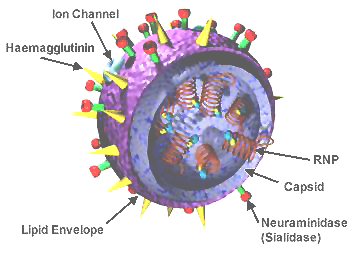Yeah, yeah, the flu virus
Since the Swine Influenza Media and Blogging Pandemic has died for now, I think I can finally write about ‘flu myself. A quick aside: until I was about 15, I thought that the word Influenza came from the Arabic “Inf-Il-enza” meaning “goat’s nose”, which it is a bit runny, like a dog’s, or like someone with the flu. My father told me that, and as was usual with him, I could never tell whether he was joking or serious. The true etymology is actually Italian: “Influence” (of the stars). Apparently stars caused the ‘flu until viruses were invented by the CIA and Big Pharma in the aftermath of The Bay of Pigs. (Hence, swine ‘flu).
Let’s be serious now.
An interesting bioinformatic analysis on the influenza virus was published recently in BMC Microbiology. Jonathan Allen and colleagues looked for pandemic markers in the proteomes of different H1N1 pandemic strains. The first thing they looked for was human host specificity. They found sixteen positions in the influenza proteome that were associated with human hosts. By doing that, they have established a framework for recognizing which influenza strains are likely to carry over from birds to humans. But not every cross-species transmission is necessarily lethal to humans. So they set up another SVM (Support Vector Machine: a statistical learning algorithm) to discover high lethality markers, using genomes from the 1918, 1957 and 1968 lethal H5N1 pandemic outbreaks, and the 1976 H1N1 New Jersey infection. Human lethality markers were mostly in Neuraminidase and Hemagglutinin proteins, the two viral proteins most associated with its virulence. The markers seem to be most prevalent in bird ‘flu strains, suggesting that birds were the primary reservoir for infection in those epidemics.
What Allen and colleagues have shown is that swine H1N1 requires the least number of steps to get to be a human pandemic, using the human pandemic conserved genomic markers. BUT — some strains might lead to H5N1 subtypes whose lethality is high.
This is a very interesting and well written paper, worth reading not only for its current relevance, but also because it is a thorough and careful study of animal to human influenza virus transfer, and of the ensuing pandemic risk.
Allen, J., Gardner, S., Vitalis, E., & Slezak, T. (2009). Conserved amino acid markers from past influenza pandemic strains BMC Microbiology, 9 (1) DOI: 10.1186/1471-2180-9-77





















[QUOTE=bytesizebio.net]Some strains might lead to H5N1 subtypes whose lethality is high.[/QUOTE]
Can you explain more simply, what you mean by this? I think that we understand that H5N1 is more likely to be lethal (unless you are a toddler In Egypt), but you went from saying H1N1 to talking about H5N1, and lost me on the way.
@Indigo girl
From the article:
“Evolutionary pathways through reassortment and mutation show that strain combinations starting with H1N1 human and swine need the fewest events to acquire the pandemic conserved markers. Several of these pathways would lead to novel strains with H5N1 subtypes that could challenge human immunity. The potential need for an extended time or number of exposures for strains to acquire the human persistent mutations combined with the high mortality rate markers associated with avian strains suggests how swine could act as a mixing vessel where both human specific and high mortality rate markers are found to persist. Additional work may reveal restrictions that limit the strain combinations that lead to viable new strains. Measuring the rate of co-infection in swine and human, particularly in cases where an avian like strain is suspected to be present, could provide additional data for more precisely modeling the likelihood of the reassortment events that combine with mutations to facilitate mutation combinations important to infection.”
Basically, this means that swine can act as a mixer, taking the minimal path to human infectivity from H1N1, and minimal path to lethality from H5N1.